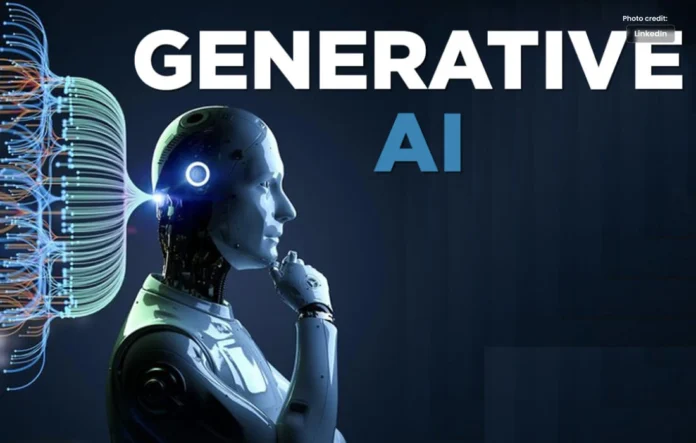Growing recognition of potential of generative AI to cybersecurity.
Organizations are realizing more and more how revolutionary generative AI can be in transforming cybersecurity tactics as they work to strengthen their defenses.
Being one step ahead of hostile actors is crucial in a time when cybersecurity threats are significant. While somewhat successful, traditional cybersecurity solutions frequently fail to keep up with the ever-evolving sophistication of cyber threats.
Read More Informative Articles In Urdu
Automation of cybersecurity defenses is greatly promising when it comes to generative AI, a branch of artificial intelligence that concentrates on producing new material or data.
Germinative artificial intelligence (AI) systems can greatly improve an organization’s overall security posture by supplementing human efforts with the ability to evaluate large volumes of data and predict possible risks through the use of machine learning techniques.
Security Using Generative AI
Fundamentally, generative AI works on the tenet of creating new insights or content by learning from preexisting data.
This technology can be used in the field of cybersecurity to find patterns, abnormalities, and possible vulnerabilities in complicated datasets that might evade the attention of conventional detection techniques.
Threat identification and analysis is one of the main uses of generative AI in cybersecurity. Through constant observation of network traffic, system records, and user behavior, generative artificial intelligence algorithms are able to recognize unusual activity that may be a sign of impending cyberattacks.
Furthermore, these systems are capable of self-adaptation and evolution in response to novel dangers and attack vectors, providing a proactive protection mechanism against ever-present risks.
Benefits of Using Generative AI to Automate Cybersecurity Defenses
Generative AI incorporation into cybersecurity frameworks has a number of strong advantages.
- Real-time Threat Detection: Organizations may react quickly to new threats by using generative AI systems, which are excellent at spotting unusual activity and possible security breaches in real-time.
- Enhanced Accuracy: Generative AI can evaluate large datasets with a high degree of accuracy by utilizing sophisticated machine learning techniques. This lowers the likelihood of missing important security incidents and reduces false positives.
- Scalability and Efficiency: Regardless of the size or complexity of their digital infrastructure, enterprises can grow their cybersecurity defenses effectively with automation driven by generative AI. Entire protection across all network endpoints and devices is ensured by this scalability.
- Defense Mechanisms That Are Adaptive: Because generative AI systems are inherently flexible and can learn from new information, they are able to continuously improve their threat detection skills and remain one step ahead of ever-changing cyberattacks.
- Cost-effectiveness: Organizations can save costs without sacrificing strong security procedures by automating repetitive cybersecurity processes and lowering reliance on human interaction.
Some Things to Think About When Using Generative AI in Cybersecurity
Although incorporating generative AI into cybersecurity defenses has several potential advantages, there are a few things that businesses need to be aware of:
- Data Privacy and Ethical Issues: Since generative AI in cybersecurity requires access to sensitive data, privacy and ethical issues are brought up. To reduce these risks, organizations must place a high priority on data protection and adherence to pertinent laws.
- Algorithmic Fairness and Bias: Generative AI models and other machine learning algorithms are subject to bias that exists in the training set. Organizations must address algorithmic bias in order to guarantee equitable and just outcomes in cybersecurity decision-making procedures.
- Human Oversight and Intervention: Although automation can make cybersecurity operations more efficient, human oversight is still necessary to verify warnings, analyze findings, and make wise judgments in challenging security situations. To optimize the effectiveness of their cybersecurity defenses, organizations should create a balance between automation and human interaction.
- Continuous Monitoring and Evaluation: In order to evaluate generative AI models’ effectiveness, spot any flaws, and take user feedback into account for future development, they must be continuously monitored and evaluated. Building strong monitoring systems is crucial to sustaining automated cybersecurity defenses’ efficacy over time.
The issue with cybersecurity is that there is an abundance of data
It’s a fact that humans are not designed to handle large volumes of data. Our attention and working memory are limited, making it difficult for us to keep and process several pieces of information at once.
We are more prone to err, overlook subtle trends, or develop bias in our interpretations the more data we handle. Our social skills, inventiveness, and intuition are our greatest strengths.
The field of cybersecurity is awash in data. The volume of data to sort through, from network traffic to log files, is astounding. It’s commonly known as the “security data deluge.” An average firm creates more than 17,000 security events every week, according to a Splunk analysis! This may result in:
- Alert fatigue: When security staff lose their sensitivity to alerts, threats go unnoticed.
- Information overload: Due to the overwhelming amount of data, analysts find it difficult to sort and evaluate it.
- Ineffective use of resources: Groups squander time and money on unimportant or false positives.
Prospects for the Future
The application of generative AI in cybersecurity is expected to grow as it develops. More advanced generative AI systems that can tackle new and complex cyber threats with unmatched precision and efficiency will be made possible by future developments in machine learning techniques and computing capacity.
Furthermore, cooperation between researchers studying AI, data scientists, and cybersecurity will spur innovation in this field and result in integrated solutions that smoothly blend automation powered by AI with human expertise.
Conclusion
The way businesses defend against cyberattacks is changing dramatically with the addition of generative AI to cybersecurity measures. Businesses may strengthen their defenses, reduce risks, and protect their digital assets in an increasingly linked world by utilizing machine learning and automation. To achieve its full potential and reduce related risks, enterprises must, however, approach the application of generative AI in cybersecurity with careful consideration of ethical, privacy, and operational issues.
Also read this: Government Issues iPhone Cybersecurity Advisory




